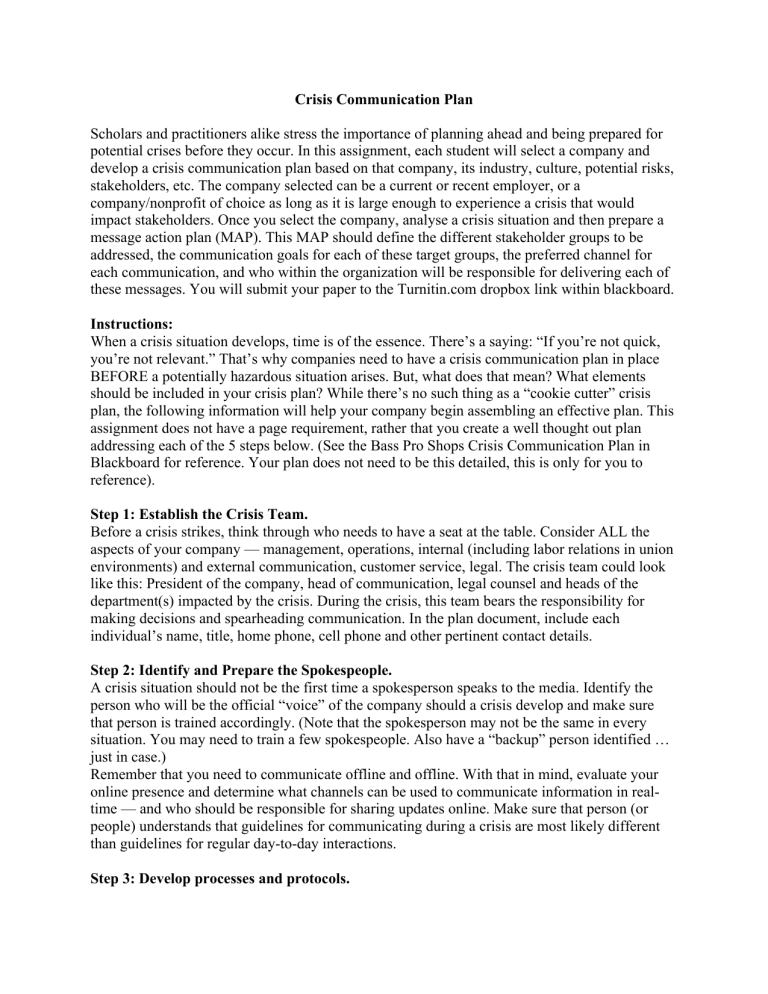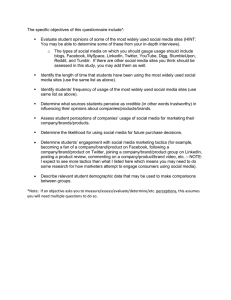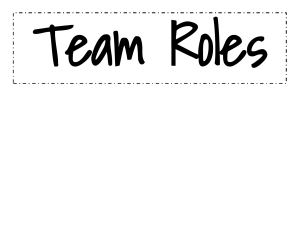
Crisis Communication Plan Scholars and practitioners alike stress the importance of planning ahead and being prepared for potential crises before they occur. In this assignment, each student will select a company and develop a crisis communication plan based on that company, its industry, culture, potential risks, stakeholders, etc. The company selected can be a current or recent employer, or a company/nonprofit of choice as long as it is large enough to experience a crisis that would impact stakeholders. Once you select the company, analyse a crisis situation and then prepare a message action plan (MAP). This MAP should define the different stakeholder groups to be addressed, the communication goals for each of these target groups, the preferred channel for each communication, and who within the organization will be responsible for delivering each of these messages. You will submit your paper to the Turnitin.com dropbox link within blackboard. Instructions: When a crisis situation develops, time is of the essence. There’s a saying: “If you’re not quick, you’re not relevant.” That’s why companies need to have a crisis communication plan in place BEFORE a potentially hazardous situation arises. But, what does that mean? What elements should be included in your crisis plan? While there’s no such thing as a “cookie cutter” crisis plan, the following information will help your company begin assembling an effective plan. This assignment does not have a page requirement, rather that you create a well thought out plan addressing each of the 5 steps below. (See the Bass Pro Shops Crisis Communication Plan in Blackboard for reference. Your plan does not need to be this detailed, this is only for you to reference). Step 1: Establish the Crisis Team. Before a crisis strikes, think through who needs to have a seat at the table. Consider ALL the aspects of your company — management, operations, internal (including labor relations in union environments) and external communication, customer service, legal. The crisis team could look like this: President of the company, head of communication, legal counsel and heads of the department(s) impacted by the crisis. During the crisis, this team bears the responsibility for making decisions and spearheading communication. In the plan document, include each individual’s name, title, home phone, cell phone and other pertinent contact details. Step 2: Identify and Prepare the Spokespeople. A crisis situation should not be the first time a spokesperson speaks to the media. Identify the person who will be the official “voice” of the company should a crisis develop and make sure that person is trained accordingly. (Note that the spokesperson may not be the same in every situation. You may need to train a few spokespeople. Also have a “backup” person identified … just in case.) Remember that you need to communicate offline and offline. With that in mind, evaluate your online presence and determine what channels can be used to communicate information in realtime — and who should be responsible for sharing updates online. Make sure that person (or people) understands that guidelines for communicating during a crisis are most likely different than guidelines for regular day-to-day interactions. Step 3: Develop processes and protocols. What’s the chain of command in a crisis? Who needs to be part of the approval process? If a reporter “scoops” the crisis before the team has been briefed, what’s the correct response? What’s the proper course of action when it appears that a crisis is brewing online? All of these are questions that need to be answered as part of your crisis plan. Having a set of approved procedures in place AHEAD OF TIME is key to responding in a timely manner and protecting the company’s brand. You don’t want to waste time trying to agree on an approval process as people share their disdain for your company via Twitter. Odds are, they’ll mobilize faster than you will — potentially causing significant damage to your brand. Step 4: Prepare for New Media’s Impact on Crisis Communication This section could probably be a whole post on its own. Crisis communication today is very different than crisis communication of years past. Everyone with a phone is a roving reporter — able to record video or take photos that may influence how the situation is perceived. Online monitoring during a crisis is critical. You need to know who is saying what and where. And, then you need to be prepared to jump into the conversation to correct facts, answer questions and share the brand’s side of the story and steps taken to fix the situation. Along those same lines, “new” crisis communication means you shouldn’t solely rely on the news media to disseminate your message. Think about opportunities to leverage multi-media to communicate. If a press conference may be appropriate, can you stream it on UStream? If so, how does that work, and what equipment do you need to purchase? Or, for impromptu statements, can you have a staffer on-hand with a Flip camera, taking footage that can be shared online? As you’re developing processes and procedures, also develop a list of potential communication tools — everything from written statements … to real-time updates via Twitter, Facebook … or multimedia — and “best practices” to leverage those tools in a crisis. Be sure to include a sample Press Conference release in written form. Step 5: Brainstorm Possible Scenarios & Responses. Role Play. Repeat. Crime. Fire and other natural disasters. Embezzlement. Bankruptcy. Communication perceived as inappropriate. In any business, there are dozens — if not more — of potential crisis situations that could ruin a brand … especially if poor communication makes the situation even worse. Identify these potential situations and develop a “response template” in the crisis communication plan. For example, if a major theft occurs, how do you respond? Can you have responses already outlined, with blanks to be filled in based on the situational details? If you’re an apartment community and a rape occurs on your property, what resources can you offer to help residents improve safety? The more preparation you can do ahead of time, the quicker you’ll be able to respond if a crisis does strike. Conduct crisis “drills” to get the team used to mobilizing quickly and working through the process. These drills should include mock on-camera interviews with the spokespeople, too. Lastly, be creative and think outside of the box with this assignment!





